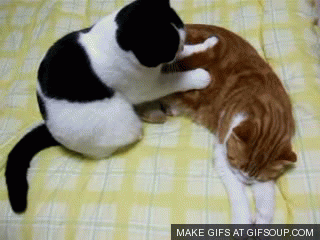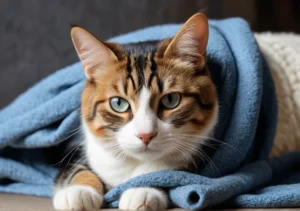Disclosure: We may earn a commission from helpful, relevant links in our content. No cost to you. See our privacy policy.
As a cat owner, you’ve probably found yourself puzzled by your feline friend’s behavior more than once.
Why does my cat suddenly turn into a kneading machine when they find a soft blanket? What does that slow, deliberate blink mean?
I remember when I first brought Smokey, my male cat, home, and he greeted me with a long, slow blink. It was a moment of pure connection, but what was he trying to tell me?
This article will delve into some common cat behaviors, helping you understand your kitty’s language and deepen your bond with your whiskered companion.

Why Do Cats Knead?
Cats knead, or “make biscuits,” by rhythmically pushing their paws in and out, often on soft surfaces like blankets, pillows, or even their owner’s lap.

This behavior is a comforting and instinctive act, rooted in their kittenhood. When nursing, kittens knead their mother’s belly to stimulate milk production.
As they grow older, cats continue to knead because it reminds them of the warmth and security they experienced as kittens.

I recall the first time Smokey climbed onto my lap and began to knead. Initially, I was confused but soon realized that it was his way of showing affection and feeling secure in his new environment.
So, the next time your cat starts kneading, take it as a compliment – they’re sharing their love and trust with you.
What’s Behind the Mysterious Slow Blink?
The slow blink is one of the most endearing cat behaviors, often referred to as a “kitty kiss.”
This gentle closing and opening of their eyes is a sign of trust and affection. When a cat slow blinks, they’re communicating that they feel safe and relaxed in your presence.
It’s a wonderful way to bond with your feline friend, and you can even reciprocate by slow blinking back at them.
One evening, as I was sitting on the couch, Smokey hopped up beside me, looked into my eyes, and slowly blinked. Feeling the warmth of this non-verbal connection, I couldn’t help but smile and slow blink back at him. It was in that moment that I realized the power of this simple gesture in building a loving relationship with my cat.
The Meaning of Raised Fur
A cat with raised fur can be quite an intimidating sight, but understanding the meaning behind this behavior can help you better support your feline companion.
Raised fur, or “piloerection,” occurs when a cat’s hair stands on end, making them appear larger and more threatening.
This reaction is usually a response to fear, stress, or agitation, and it serves as a defense mechanism to ward off potential threats.
I remember when Smokey first encountered the neighbor’s dog. His fur stood on end, making him look twice his normal size. Seeing his reaction, I quickly stepped in, picked Smokey up, and brought him back inside, away from the source of stress. Knowing the meaning behind raised fur allowed me to recognize his fear and respond accordingly to keep him safe and comfortable.
Is My Cat Happy When They Wag Their Tail?
Contrary to popular belief, a wagging tail is not always a sign of happiness in cats. In fact, it often indicates agitation, annoyance, or a heightened emotional state.
Observing your cat’s body language as a whole will provide more accurate insight into their emotional state.
I once misread my cat’s wagging tail as a sign of joy, only to be met with a hiss when I tried to pet him. After learning more about feline body language, I realized his tail wagging actually meant he was feeling irritable and needed some space.
Unraveling the Cat’s Hunting Instincts
Cats are natural-born hunters, and their instincts drive them to stalk, pounce, and play with their “prey.”
It’s important to provide your cat with opportunities to express these instincts in a safe and controlled environment through interactive play, toys, and puzzle feeders. (Here are the best-selling toys on Amazon, and here are the puzzle feeders).
Offering your cat proper physical and mental enrichment significantly improves their well-being and happiness.
If you find your cat stalking a toy mouse, with their eyes wide and body low to the ground, why not join in? Wiggle the toy, and they will pounce with impressive precision. This play session not only satisfies their hunting instincts but also strengthens your bond as you share a fun, interactive experience.
FAQs
Why does my cat suddenly bite me while being petted?
Your cat may bite during petting due to overstimulation or sensitivity in certain areas. Pay attention to their body language and stop petting when they show signs of discomfort or agitation. If they are light bites, you cat may simply be playing with you and showing affection.
Is it normal for a cat to knead with its paws?
Yes, kneading is a normal cat behavior that typically begins in kittenhood and is associated with comfort, contentment, and relaxation.
Why does my cat sleep so much during the day?
Adult cats sleep for an average of 15 hours a day to conserve energy for their natural hunting activities, which are more likely to occur during dawn and dusk.
Are cats really nocturnal animals?
Cats are not strictly nocturnal but are actually crepuscular, which means they are most active during dawn and dusk when their prey is typically more active.
Alex, a passionate animal lover, has experience in training and understanding animal behavior. As a proud pet parent to two dogs and three cats, he founded AnimalReport.net to share insights from animal experts and expand his knowledge of the animal kingdom.




